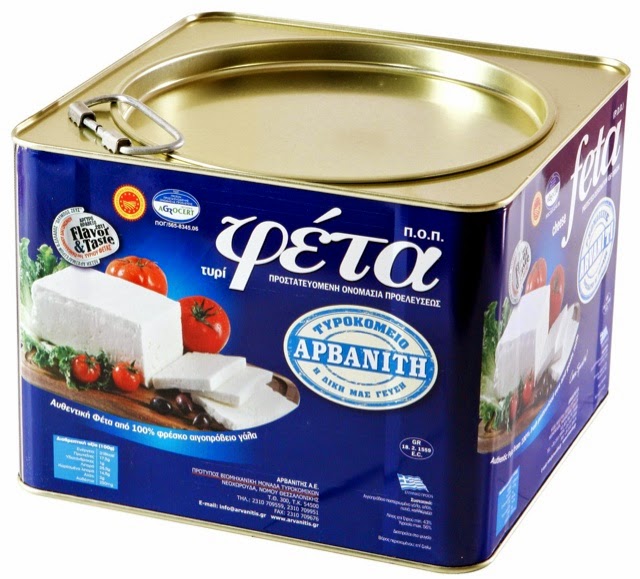Feta cheese isn't just a Greek cheese, it's a way of life for most Greeks and it's one of their oldest food traditions. So, in typical Mediterranean style, a little voyage back to the Byzantine Empire where the production of feta was first recorded.
No Greek celebration is complete without copious amounts of feta drenched in olive oil and sprinkled delicately with dried Greek oregano. But it is most at home when tumbled through a Greek salad: tomatoes, cucumbers, green peppers, white onions and, of course, Olives- the kalamata variety being my particular favourite.
Feta also makes a delicious omelette- just crumble some in half way through cooking with some peas and dried mint. Simplicity at its best and extremely nutritious, especially for those on a high protein diet!
But today we're talking pie and Spanakotyropita or Spanakotyropitakia (little pies) are a staple of both Greek home cooking and 'fast food'. You will find them pride of place at the front of most display cases in Greek bakeries. That's if you're lucky enough to snap one up in time- they prove to be a popular breakfast or lunchtime snack!
So how do you make this infamous pie? It's super simple though does require a little patience; a discipline that must be embraced if you are to perfect Greek cuisine. So where do we start? You will need the following ingredients:
1 kilo of baby spinach
400-500g Feta
2 red onions
2 eggs
Nutmeg
Filo pastry (at least 12 sheets)
Unsalted butter
Fresh dill, finely chopped (100g)
Pepper
1.5 litre capacity oven proof dish
Pastry brush
This should feed 6 lucky people or 4 greedy Greek people.
Preheat the over to 200 degrees celcius.
Start off by finely dicing the onion and sauté on a low heat for at least 10 minutes to really extract their sweetness. Leave to cool.
Meanwhile, bring a large sauce of water to the boil and blanche the spinach until it wilts- no longer than a minute. Rinse with cold water and, drain and leave to cool completely. Once cooled, take handfuls of the spinach and, over the sink, squeeze out as much water as you can and set aside in a large bowl.
Add the cooled onion to the spinach and crumble in the feta. Beat the eggs and add them to the bowl. Sprinkle in the dill and grate in half a nutmeg. Pepper to taste. Gently toss the mixture, careful not to completely break up the feta into a mush.
Place the butter on a microwaveable bowl and microwave until completely melted.
Lightly flour a surface and take one sheet of the filo pastry. With the pastry brush, lightly butter the sheet and then layer another one on top. Repeat this process 6 times. Carefully lift the sheets and place loosely into the over proof dish.
Now complete the process again with the remaining 6 sheets. Gently spread the mixture on top of the bedded sheets and then place the remaining 6 on top. Gently ensure that all sides of the pie are sealed and bring any overlapping bits over the top of the pie and butter the top one last time. Gently fork the top of the pie to create steam vents.
Place in the centre of the oven (200 degrees) and cook for a 25-30 minutes or until golden brown on top.
Once cooked, allow to cool slightly for 10-15 minutes for the pie to set. Slice and enjoy!
This pie is best eaten with moundfuls of freshly-made Tzatziki. You will not be disappointed!
Tips:
1. Try to source your filo pastry from a Greek retailer as the sheets tend to be much larger. At the very least, make sure it is 'all butter' pastry. If you're brave enough, make your own! Another alternative is to use puff pastry: simply cut a standard pastry block into two, roll each piece out and place one on the bottom of a ovenproof dish, spoon on filling and place the other piece on top, making sure the filling is nicely snug so nothing oozes out. Again glaze with egg and fork to create air vents.
2. Don't underestimate the amount of spinach. Uncooked, a kilo looks like a lot but, believe me, it wilts down to next to nothing.
3. Make sure you buy a good quality feta bearing in mind the milk contents as discussed above. Oak barrelled is even better.
4. Do not use alternatives to dill- It won't work. Dill is the silent star of this dish and it is simply incomplete without it.
5. As temping as it is, do not cut it straight out of the oven! It really does taste better once cooled a little. Patience is a virtue!
Καλή όρεξη!!! :)))




How to Play Baccarat | FBCasino
ReplyDeleteFor example, if 인카지노 you want to play the game Baccarat at the 바카라사이트 table where the bet is placed, you หาเงินออนไลน์ need to predict which numbers will appear next to that number